Gian Giacomo Quadri, known as Dolcebuono (c. 1445 – 1504) was an Italian architect and sculptor.

Italy, officially the Italian Republic, is a country in Southern Europe. Located in the middle of the Mediterranean Sea, Italy shares open land borders with France, Switzerland, Austria, Slovenia and the enclaved microstates San Marino and Vatican City. Italy covers an area of 301,340 km2 (116,350 sq mi) and has a largely temperate seasonal and Mediterranean climate. With around 61 million inhabitants, it is the fourth-most populous EU member state and the most populous country in Southern Europe.
Born probably in Lugano, he was a relative of Giacomo Antonio Dolcebuono, who had provided one of the first projects for the façade of the Certosa di Pavia. Quadri apprenticed in the Milanese workshop of Giovanni and Guiniforte Solari together with Giovanni Antonio Amadeo. Already present in the city's Duomo, in 1473 he executed decorations for the church of Santa Maria presso San Celso and for the major cloister and the façade of the Certosa di Pavia.

Lugano is a city in southern Switzerland in the Italian-speaking canton of Ticino bordering Italy. It has a population of 63,494, and an urban agglomeration of over 145,000. The 9th largest Swiss city, it is the largest in Ticino and largest with an Italian speaking majority outside of Italy. The city lies on Lake Lugano, surrounded by the mountains of the Lugano Prealps. The eastern part of the city shares a border with Italy.

The Certosa di Pavia is a monastery and complex in Lombardy, northern Italy, situated near a small town of the same name in the Province of Pavia, 8 km north of Pavia. Built in 1396-1495, it was once located on the border of a large hunting park belonging to the Visconti family of Milan, of which today only scattered parts remain. It is one of the largest monasteries in Italy.

Milan is a city in northern Italy, capital of Lombardy, and the second-most populous city in Italy after Rome, with the city proper having a population of 1,372,810 while its metropolitan city has a population of 3,245,308. Its continuously built-up urban area has a population estimated to be about 5,270,000 over 1,891 square kilometres. The wider Milan metropolitan area, known as Greater Milan, is a polycentric metropolitan region that extends over central Lombardy and eastern Piedmont and which counts an estimated total population of 7.5 million, making it by far the largest metropolitan area in Italy and the 54th largest in the world. Milan served as capital of the Western Roman Empire from 286 to 402 and the Duchy of Milan during the medieval period and early modern age.
In 1488, again together with Amadeo, he replaced Cristoforo Rocchi in the construction of the Pavia Cathedral. Two years later the two stated the construction of the dome and the tambour of the Duomo of Milan. Again with Amadeo, he designed the church of San Maurizio al Monastero Maggiore.

Pavia Cathedral is a church in Pavia, Italy, the largest in the city and seat of the Diocese of Pavia. The construction was begun in the 15th century on the site of two pre-existing Romanesque, "twin" cathedrals. The cathedral houses the remains of St. Sirus, first Bishop of Pavia, and a thorn purported to be from the Crown of Thorns worn by Christ. The marble facing of the exterior was never completed.

San Maurizio al Monastero Maggiore is a church in Milan, northern Italy. It was originally attached to the most important female convent of the Benedictines in the city, Monastero Maggiore, which is now in use as the Civic Archaeological Museum. The church today is used every Sunday from October to June to celebrate in the Byzantine Rite, in Greek according to the Italo-Albanian tradition. It is also used as concert hall.
He died in Milan in 1504.











